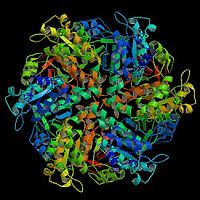
Photo from wikipedia
Chromosomal rearrangements that lead to recombination suppression can have a significant impact on speciation, and they are also important for breeding. The regions of recombination suppression in wheat chromosome 5B… Click to show full abstract
Chromosomal rearrangements that lead to recombination suppression can have a significant impact on speciation, and they are also important for breeding. The regions of recombination suppression in wheat chromosome 5B were identified based on comparisons of the 5B map of a cross between the Chinese Spring (CS) variety of hexaploid wheat and CS-5Bdic (genotype CS with 5B substituted with its homologue from tetraploid Triticum dicoccoides) with several 5B maps of tetraploid and hexaploid wheat. In total, two regions were selected in which recombination suppression occurred in cross CS × CS-5Bdic when compared with other maps: one on the short arm, 5BS_RS, limited by markers BS00009810/BS00022336, and the second on the long arm, 5BL_RS, between markers Ra_c10633_2155 and BS00087043. The regions marked as 5BS_RS and 5BL_RS, with lengths of 5 Mb and 3.6 Mb, respectively, were mined from the 5B pseudomolecule of CS and compared to the homoeologous regions (7.6 and 3.8 Mb, respectively) of the 5B pseudomolecule of Zavitan (T. dicoccoides). It was shown that, in the case of 5BS_RS, the local heterochromatin islands determined by the satellite DNA (119.2) and transposable element arrays, as well as the dissimilarity caused by large insertions/deletions (chromosome rearrangements) between 5BSs aestivum/dicoccoides, are likely the key determinants of recombination suppression in the region. Two major and two minor segments with significant loss of similarity were recognized within the 5BL_RS region. It was shown that the loss of similarity, which can lead to suppression of recombination in the 5BL_RS region, is caused by chromosomal rearrangements, driven by the activity of mobile genetic elements (both DNA transposons and long terminal repeat retrotransposons) and their divergence during evolution. It was noted that the regions marked as 5BS_RS and 5BL_RS are associated with chromosomal rearrangements identified earlier by С-banding analysis of intraspecific polymorphism of tetraploid emmer wheat. The revealed divergence in 5BS_RS and 5BL_RS may be a consequence of interspecific hybridization, plant genetic adaptation, or both.
Journal Title: Frontiers in Plant Science
Year Published: 2022
Link to full text (if available)
Share on Social Media: Sign Up to like & get
recommendations!